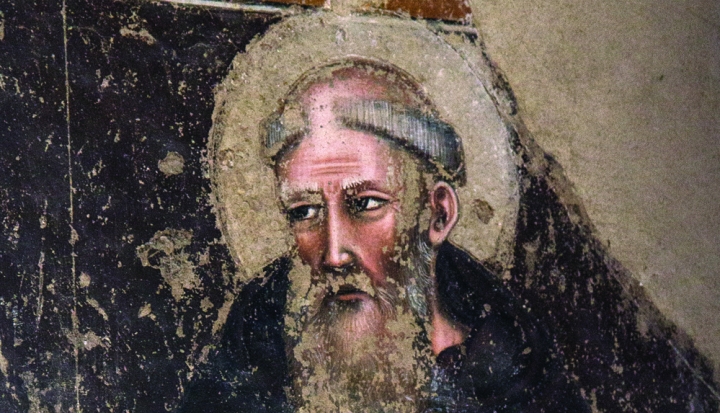St. Benedict is a wise guide and presence in my life through the teachings he left in his Rule for monasteries. Benedict was born in Nursia, Italy and died at the abbey he founded in Monte Cassino (c. 480–547). All that we know of his life comes from Pope Gregory the Great, who wrote a biography about the monk and saint 50 years after Benedict’s death. Gregory describes how Benedict lived for three years in a cave in Subiaco as a hermit until others began to seek him out and formed a community around him. There are miracles associated with the saint as well. He is said to have performed several, including bringing a child back to life.
The Hildegard connection
I have been a Benedictine oblate for 15 years. To be a Benedictine oblate means to commit oneself as a layperson to live out the Rule of St. Benedict in the everyday world. Although Benedict wrote his Rule 1,500 years ago, what is perhaps most remarkable is how well its wisdom endures. Today it continues to guide the spiritual practice of thousands of communities around the world.
I first discovered the Benedictine way when I was in graduate school. In studying for my history of Christian spirituality exam I encountered St. Hildegard of Bingen, a 12th-century Benedictine abbess from Germany who was a preacher, theologian, visionary, musician, artist, herbalist, and spiritual director. The more I studied her, the more I wanted to learn about this Benedictine tradition in which she was so steeped.
I consider Hildegard to be the patron saint of my becoming an oblate. She opened the door for me into this contemplative way of life that so resonated with who I was and how I longed to pray. In Benedict’s Rule I discovered a beautifully balanced vision for the spiritual life, both in solitude and in community. Benedict did not believe in harsh, ascetic practices. He was critical of those who aimed for a kind of spiritual competition or went to extremes of fasting or other forms of self-denial.
Benedictine spirituality and disability
Two books by author and theologian Mary Earle for those living with chronic illness helped me fall even more in love with the Rule’s commitment to balance, moderation, and finding a healing rhythm to life: Beginning Again: Benedictine Wisdom for Living with Illness (Morehouse Publishing) and Broken Body, Healing Spirit: Lectio Divina and Living with Illness (Morehouse Publishing). I struggled with rheumatoid arthritis for much of my 20s. I still have the disease, but it is mostly controlled with medication. The Benedictine path helped me to claim the contemplative way, which I saw was not only truer to my nature but also more nourishing of a life lived with physical limitations.
In studying Benedict’s Rule I also discovered the practice of lectio divina, which means “sacred reading.” This practice is one of the oldest Christian contemplative ways of prayer. Traditionally used to pray with scripture and other sacred texts, lectio divina has inspired me to see all of life as a sacred text in which to listen for a holy word from icons, music, and nature.
There are three primary commitments in the Benedictine way that form the spiritual backbone for the rest of the spiritual practices—obedience, stability, and conversion.
Obedience, stability, and conversion
The root of the word obedience means “to hear” and is about making a commitment to listen for God’s voice in the world and respond when you hear the call. Obedience is a difficult concept for modern Western thinkers. Consider it as a way of deep listening for the holy in all dimensions of your life. The second part of this listening is a response: Am I willing to not only make the time and space to listen for God’s call, but to also respond with my full self?
Stability for monastics means making a commitment to a particular monastery for a lifetime. For those of us who are committed to monastic practices outside of the monastery walls, consider it as a commitment to be present to life circumstances even through challenges. This might apply to a marriage or friendship, to our work life, or simply to daily challenges. Can I stay present to the moment and how God is speaking even when I’m uncomfortable or in conflict? Or do I want to run in the other direction?
Then there is conversion, which for me essentially means making a commitment to always be surprised by God. Conversion is the counterpart to stability. It is the recognition that we are all on a journey and always changing. God is always offering us something new within us. How might my spiritual life transform by opening myself up to the new possibilities God is continually offering each moment?
Sacred hospitality
One of my favorite lines from Benedict’s Rule is: “All guests who present themselves are to be welcomed as Christ, for he himself will say: I was a stranger and you welcomed me.” I love this invitation to welcome that which feels the most strange and uncomfortable as the very face of the divine. The stranger might be outside of us but just as easily is within us. We each have parts of ourselves we try to push away. In the Benedictine monastic tradition, everything is considered sacred—all people, all things, and all of time. The stranger at the door is to be welcomed in as Christ. The kitchen utensils are to be treated just like the altar vessels. The hours of the day call us to remember the presence of God again and again so that time becomes a cascade of prayers.
In 2009 I traveled to Rome for the World Congress of Benedictine Oblates, where I met other oblates from around the world. We made pilgrimages to sacred sites connected with Benedict, such as the cave in Subiaco and Monte Cassino, the central monastery he founded high upon a hill. Monte Cassino is a large and flourishing place where many pilgrims seeking spiritual connection go. I still treasure my Benedict medal from there, which I wear daily around my neck as a symbol of my commitment.
Benedictine wisdom forms the heart of my daily spiritual practice, along with the teaching I do. I call it becoming a monk in the world, to learn how to embrace this way of being and offer it as a gift to a world always so busy and frenzied. In living this way I witness to an alternative way of being, one rooted in slowness and spaciousness, one inspired by what Benedict called the “inexpressible delight of love.”
This article also appears in the August 2019 issue of U.S. Catholic (Vol. 84, No. 8, pages 45–46).
Image: Flickr cc via Fr. Lawrence Lew, O.P.















Add comment